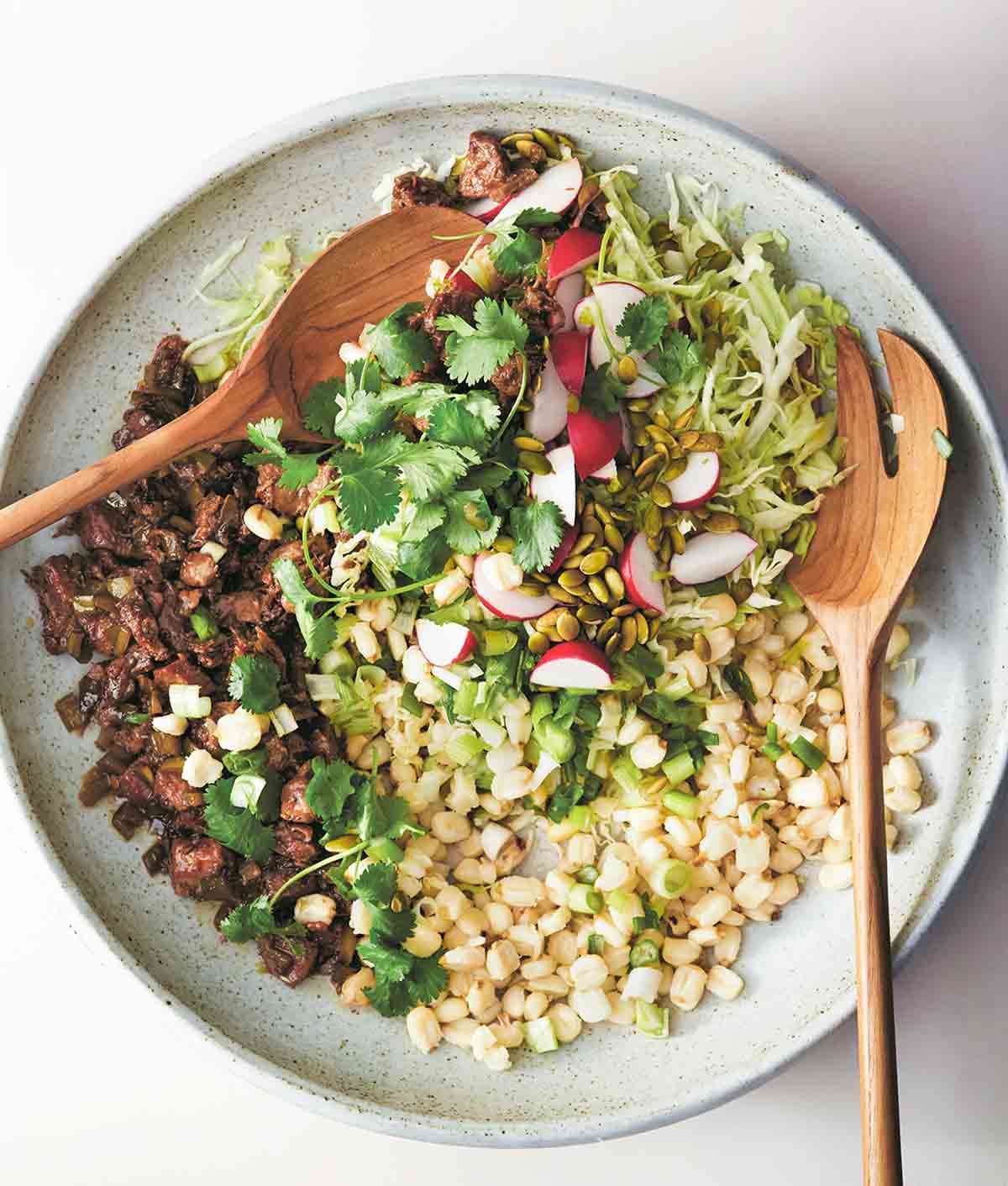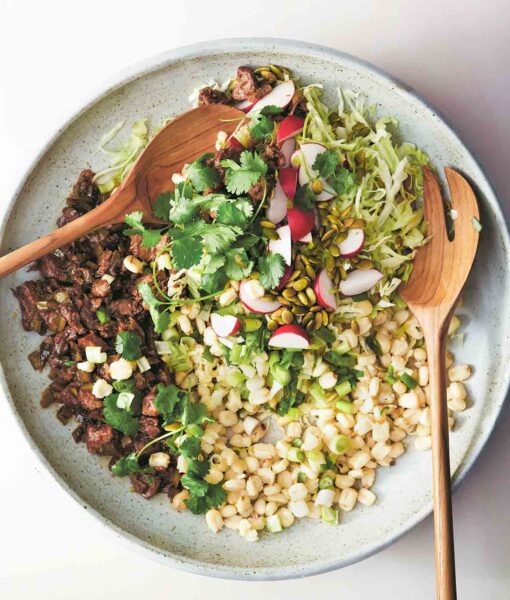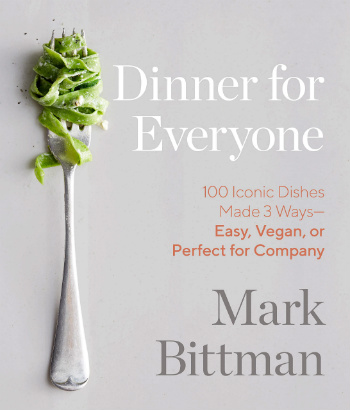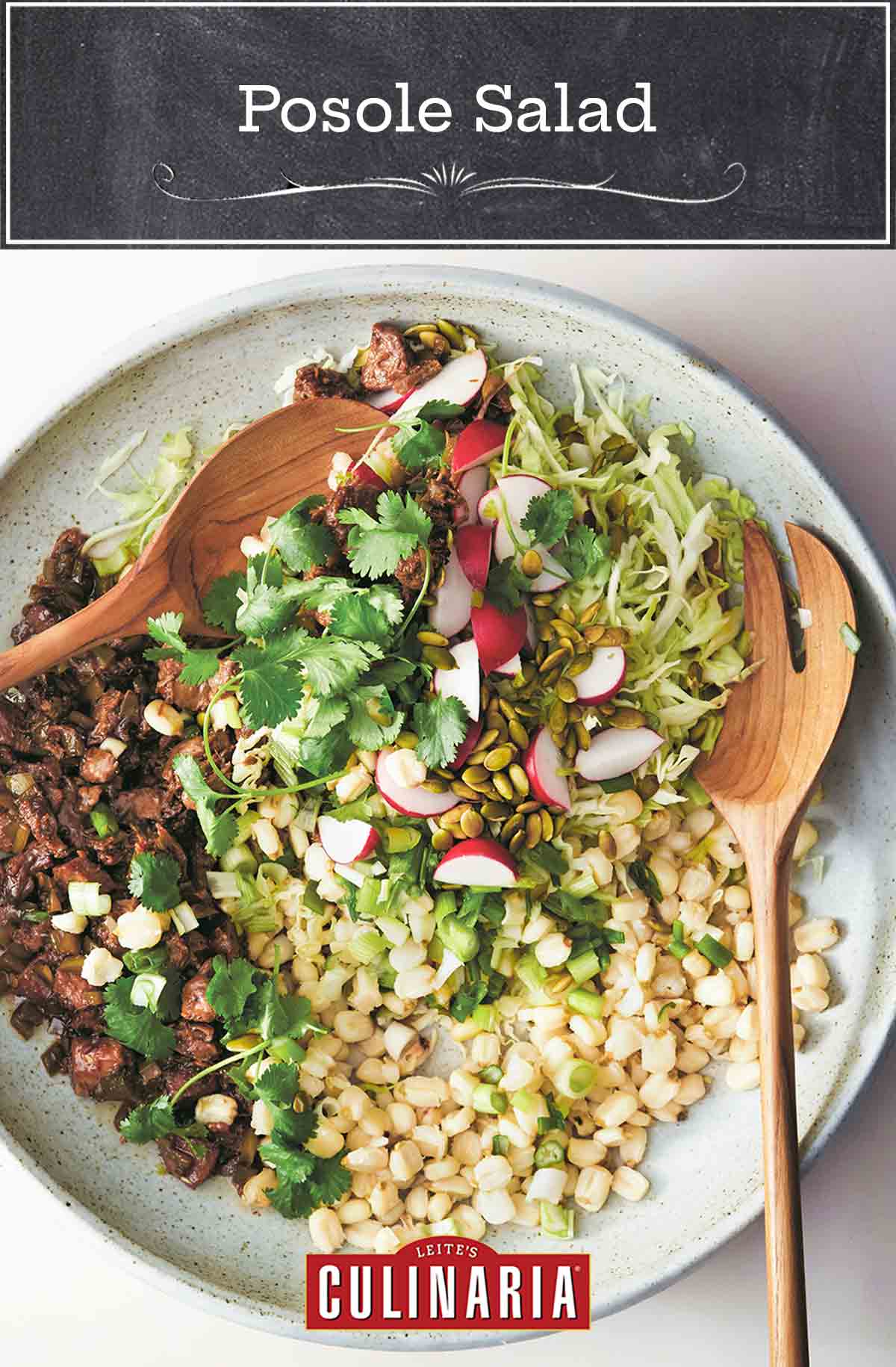
This posole salad offers up all the familiar flavors of the traditional Mexican soup in a decidedly unconventional riff that satisfies your craving even during the dog days of summer. Like the classic, it calls for shredded pork shoulder inflected with red chile, hominy, cabbage, radish, cilantro, and plenty of lime.–Angie Zoobkoff
Posole Salad FAQs
Hominy corn is essentially just field corn that’s been processed to give it a puffy, more meaty texture. To be made into hominy, corn kernels have to go through a process called nixtamalization (soaking it in lye). This gives the kernels a softer hull, making them easier to digest. Hominy is also often coarsely ground into grits and it’s what makes the fine flour masa, the main ingredient in tortillas.
To use dried hominy rather than canned, in a medium saucepan, combine the hominy with a large pinch of salt and enough water to cover by at least 2 inches (5 cm). Bring to a boil and then adjust the heat so the mixture bubbles gently. Cook, stirring occasionally until the hominy is tender and tastes done to your liking. Start checking after 30 minutes; it could take up to 2 hours, depending on how old (and therefore dry) your hominy is. Drain and leave the hominy in the colander to cool.
If you don’t have cheesecloth on hand, a teaball works quite dandily for containing the spices.

Posole Salad
Ingredients
- 1 cup dried white hominy or 2 1/2 cups drained cooked hominy (from one 25-oz | 708-g can)
- 1 bay leaf
- 2 teaspoons cumin seeds
- 2 teaspoons coriander seeds
- 1 ancho or other mild dried chile
- 1 pound boneless pork shoulder, cut into 1-inch (25-mm) chunks
- 1 large onion, quartered
- 3 garlic cloves, lightly crushed
- Freshly ground black pepper
- One (12-ounce) bottle Mexican lager
- Mild vegetable oil, as needed
- 1/2 cup fresh lime juice, from 4 to 5 limes, plus more to taste
- 2 jalapeños, seeded and finely chopped
- 2 cups shredded green cabbage
- 4 ounces radishes, trimmed and chopped (about 4)
- 4 scallions, chopped
- 1 cup fresh cilantro sprigs, tough stems removed
- 1/4 cup toasted pumpkin seeds
Instructions
- If using canned hominy, dump the hominy into a , rinse, and drain. If using dried hominy, see the FAQs above.
- Meanwhile, in a large piece of cheesecloth, wrap the bay leaf, cumin, coriander, and chile and secure tightly.
- Toss in a large pot the spice pouch, pork, onion, and garlic, and sprinkle with salt and pepper. Add the beer and as much water as needed to cover the whole shebang by 1 inch (25 mm).
- Bring to a boil and skim any foam that comes to the surface. Partially cover and adjust the heat so the mixture bubbles gently and steadily. Cook until the pork can be easily pierced with a fork, 1 1/4 to 1 3/4 hours.
- Remove the cheesecloth bundle and the chunks of onion with a slotted spoon and discard. Use a spoon to break the meat into bite-sized pieces and cook, uncovered, until all the liquid has evaporated, about 50 minutes.
- Continue to cook the pork in the remaining fat, keeping a careful watch the entire time and adjusting the heat as necessary to prevent it from burning, until the pork is crisp and brown, 10 to 15 minutes. Add a little oil if the pork sticks to the pot or becomes dry.
- Move the pork to a large bowl or platter.
- Reduce the heat under the pot to medium. Add the lime juice and jalapeños to the pot and cook, stirring, until all the browned bits stuck to the bottom of the pan have come loose. Season with salt and pepper and then drizzle the juices over the pork. Toss to coat and then taste and adjust the seasoning accordingly, adding more lime juice if you’d like.
- Arrange the hominy, cabbage, radishes, scallions, and cilantro on the pork or simply toss everything together. Taste and adjust the seasoning again, if desired. Sprinkle with pumpkin seeds.

Nutrition
Nutrition information is automatically calculated, so should only be used as an approximation.
Recipe Testers’ Reviews
This was a bright and crunchy posole salad with an excellent and smokey sort of pork flavor which really makes the dish! I’ll definitely be using this pork for other things like tacos, etc.
I liked this posole salad because it used ingredients that I rarely use (or know how to use) such as cabbage, radish, etc. Oh, I hate cilantro so I didn’t use it! I’m sorry! I also only used 1 jalapeño as I was making this dish for my kids. One said it was perfect as-is and the other said it was slightly spicy. I would be wary of using 2 if making for kids who aren’t used to heat.
I didn’t have any cheesecloth so just used the spices on their own and removed the onion, bay leaf, and garlic when the recipe suggested. The whole spices were fine left in and added extra smokiness to the bottom of the pot which all came out with the lime juice.
I used a 1.20 lb bone-in pork shoulder and cut as best I could around the bone. I actually threw the bone in for the initial cooking and just removed it with the bay leaf and onion.
The final result was tasty but I wanted more crunchiness so I added 1 extra cup of cabbage!
I enjoyed the bright, lime-forward taste of the tender, moist pork in this posole salad. I would enjoy making this again—my husband seconds this sentiment. The cabbage, radish, and pumpkin seeds are nice crunchy elements that make this a very refreshing and healthy dinner, especially on a hot night.
I had to add 8 cups of water to the beer to braise the meat. The salad is definitely only a 2 serving dish. We are light meat-eaters and by the time the meat braises etc, a lot of fat has melted off the shoulder, and so you end up with about 8 ounces of meat, 4 ounces per serving. You’d only have a couple of bites stretch this to four servings. Next time I’ll double the recipe.
I used canned white hominy since I couldn’t find dried. I used two cans.
This salad has such a great flavor profile. The hoppiness of the beer came through along with the cumin, coriander, and ancho chili. The flavors were subtle, but present. The textures and colors made for beautiful plating, but what I enjoyed most was the lime and jalapeño sauce on the pork.
I used canned hominy and heated and seasoned it before straining. It does take a little time to cook the meat and you do need to watch the evaporation, but it is every bit worth the effort.
A salad with main-dish meatiness and flavor, this has well-developed and concentrated flavors to reward for the time commitment. Although this is not an epic 2- or 3-day posole, the meat, and hominy are still going to take several hours, bubbling away patiently. Initially, I made this using tinned hominy partly to save that part of the preparation, and while it worked, by the time the meat had reduced all the liquid, I felt I could easily have had a batch of hominy running in parallel.
For the pork, it seemed like a large amount of liquid to evaporate, but the eventual concentration was delicious. It still seemed a bit too wet to become crisp without scorching, and the evaporation time meant it shredded more like carnitas, but the lime juice deglazing pulled it all together, and I kind of wish I had more of that! The jalapeño (one enormous one) just blended into a delicious tho not too fiery hot glaze. The finely shredded cabbage and chopped radishes were great contrast (and if you slice the cabbage thinly with a knife instead of a mandoline, that will be just fine; you need about a quarter of a large head of cabbage). Reheating the second day, I added the juice of a small lime and that helped with making the flavours more evenly distributed.
I think the texture and flavor of freshly cooked hominy is worth the time if you can do it, but, otherwise, a large can of ready-to-use hominy will work.
I felt the flavors needed to be tossed together, which distributed the meat well enough to be satisfying and a tablespoon of toasted pepitas were a great garnish along with some sea salt. Reheating the second day, I added the juice of a small lime and that helped make the flavors more evenly distributed, and served it arranged, letting each serving be mixed as it was eaten, and surrounded it with tiny tomatoes sliced in half which made it feel more as a salad.
The meat doesn’t end up as nicely pieced as the photo suggests, so maybe they cooked larger pieces or mine just took longer and was past that stage. It was still delicious.
The only issue was the amount of hominy I used was too much for the meat. I’ll use a little less the second time. The posole and hominy alone lack the infused flavor that makes it so good in stews, but alone is bland and needs dressing and restrained amounts. Making sure the dressing and ingredients are tossed together may take away from pretty plating, but delivers a better first bite.













Such a creative option for summer when it’s too warm for posole soup! With several vegetarian friends, shrimp was simmered in the ale and spices instead of the pork. I look forward to making the pork version in the future as it sounds so good how it is cooked down. Also, added your pickled red onions. Overall, everyone loved this salad 🙂
Wonderful, Lily. Just wonderful. And I love the swap in of shrimp. Very creative! Looking forward to seeing what you make next on the site.